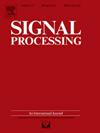Distributed reduced-order Kalman consensus filter for multisensor networked descriptor systems
IF 3.4
2区 工程技术
Q2 ENGINEERING, ELECTRICAL & ELECTRONIC
引用次数: 0
Abstract
In the context of multisensor linear discrete networked descriptor systems, an equivalence transformation, achieved via singular value decomposition, leads to the derivation of two lower-dimensional non-descriptor subsystems. Each network node can perform state estimation based on data of its own and its neighboring nodes. Applying the Kalman consensus filter (KCF) framework, wherein one-step prediction estimates of a reduced-order subsystem are exchanged among network nodes, a distributed reduced-order KCF is designed for each sensor node, incorporating multiple consensus gains. This design facilitates collaborative state estimation by enabling nodes to leverage both their own measurements and the prediction estimates received from their neighbors. The optimal Kalman filtering gains and the optimal consensus filtering gains are determined by minimizing the trace of the filtering error covariance matrix. The investigation delves into the stability and steady-state characteristics of the tailored distributed reducer-order filtering systems. The performance of the algorithms is confirmed through illustrative simulation cases.
多传感器网络广义系统的分布式降阶卡尔曼一致滤波
在多传感器线性离散网络描述子系统中,通过奇异值分解实现等价变换,推导出两个低维非描述子系统。每个网络节点都可以根据自己和邻近节点的数据进行状态估计。应用卡尔曼共识滤波器(Kalman consensus filter, KCF)框架,在网络节点之间交换降阶子系统的一步预测估计,为每个传感器节点设计了一个包含多个共识增益的分布式降阶KCF。这种设计通过使节点能够利用它们自己的测量和从相邻节点接收到的预测估计来促进协作状态估计。最优卡尔曼滤波增益和最优一致滤波增益是通过最小化滤波误差协方差矩阵的迹来确定的。研究了定制分布式降阶滤波系统的稳定性和稳态特性。通过仿真实例验证了算法的有效性。
本文章由计算机程序翻译,如有差异,请以英文原文为准。
求助全文
约1分钟内获得全文
求助全文
来源期刊

Signal Processing
工程技术-工程:电子与电气
CiteScore
9.20
自引率
9.10%
发文量
309
审稿时长
41 days
期刊介绍:
Signal Processing incorporates all aspects of the theory and practice of signal processing. It features original research work, tutorial and review articles, and accounts of practical developments. It is intended for a rapid dissemination of knowledge and experience to engineers and scientists working in the research, development or practical application of signal processing.
Subject areas covered by the journal include: Signal Theory; Stochastic Processes; Detection and Estimation; Spectral Analysis; Filtering; Signal Processing Systems; Software Developments; Image Processing; Pattern Recognition; Optical Signal Processing; Digital Signal Processing; Multi-dimensional Signal Processing; Communication Signal Processing; Biomedical Signal Processing; Geophysical and Astrophysical Signal Processing; Earth Resources Signal Processing; Acoustic and Vibration Signal Processing; Data Processing; Remote Sensing; Signal Processing Technology; Radar Signal Processing; Sonar Signal Processing; Industrial Applications; New Applications.
 求助内容:
求助内容: 应助结果提醒方式:
应助结果提醒方式:


